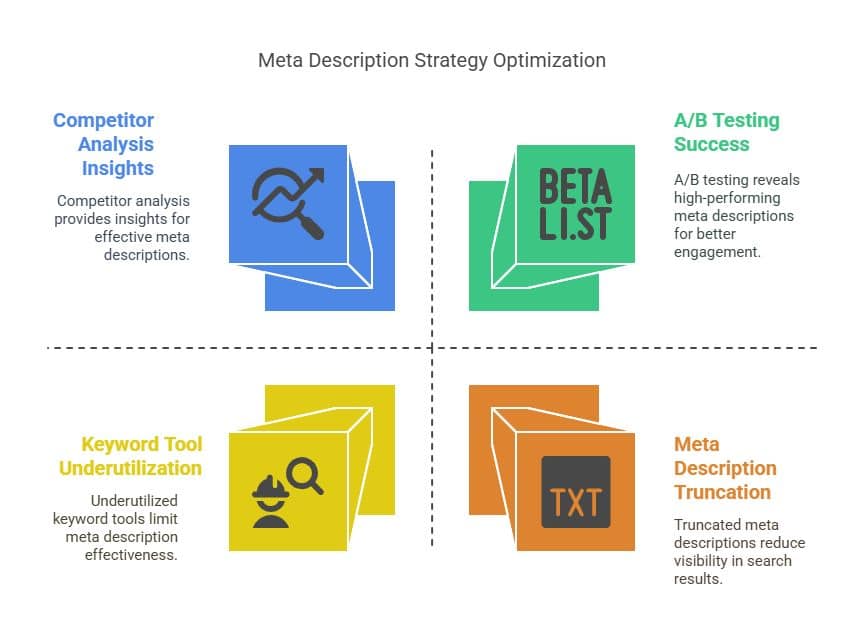
How to Analyze Meta Descriptions for Better Rankings
To improve your meta descriptions for better rankings, make sure they match what users are looking for and include well-researched keywords. Keep them short and clear, ideally between 150-160 characters, to prevent them from being cut off and to capture user attention. Write a unique description for each page to make your content stand out. Track click-through rates (CTR) to see how well your descriptions are performing and adjust accordingly. Use A/B testing and SEO tools to understand user engagement and improve effectiveness. Regularly optimizing based on performance is key to staying ahead in search results. Discover more insights on meta descriptions and SEO performance analysis.
Key Takeaways
- Keep meta descriptions brief—ideally between 150 and 160 characters—to prevent truncation in search results.
- Use keyword tools to identify relevant and high-performing keywords aligned with user search intent.
- To assess the effectiveness of meta descriptions and make data-driven adjustments, monitor click-through rates.
- Analyze your competitors to find effective meta description techniques and prospects for original content.
- To determine which meta description variants increase rankings and user engagement, regularly run A/B tests on a number of them.

Importance of Meta Descriptions
Meta descriptions have a significant impact on user engagement and enhancing search engine rankings. They serve as a concise summary of a webpage’s content, appearing beneath the URL in search engine results. Crafting compelling copy is essential for capturing the attention of potential visitors and enticing them to click through to your site.
To achieve this, adhering to meta description best practices is crucial. This includes keeping the length between 150-160 characters to ensure full visibility in search results and avoiding truncation.
Understanding user intent is fundamental when writing meta descriptions. By aligning the description with what users are likely searching for, you can significantly increase the chances of attracting relevant traffic. This involves not only reflecting the content accurately but also predicting what information users seek and how they phrase their queries.
In today’s digital landscape, optimizing for mobile is critical. With a significant portion of searches conducted on mobile devices, ensuring your meta descriptions are mobile-friendly can enhance user experience and improve click-through rates. This means being concise and ensuring that important information appears early in the description.
Incorporating calls to action (CTAs) within meta descriptions can further drive engagement. Phrases like “Learn more,” “Discover now,” or “Get started” can create a sense of urgency and encourage users to take the desired action.
Identifying Target Keywords

Crafting effective meta descriptions requires a strategic approach to identifying target keywords that resonate with your audience. To achieve this, leveraging keyword tools is essential. These tools provide insights into search volume, competition, and trends, helping to pinpoint which keywords are not only popular but also relevant to your content.
Understanding search intent is another critical aspect; it involves discerning the underlying motivation behind a user’s query. By aligning your meta descriptions with the user’s intent, you can enhance their relevance and appeal, encouraging clicks and improving rankings.
Another vital step in identifying target keywords is competitor analysis. By examining the keywords your competitors are using, you can uncover opportunities to differentiate your content or identify gaps in their strategy that you can exploit. Competitor analysis provides a benchmark, allowing you to understand what is working well in your industry and adapt those insights to fit your unique content themes.
Content themes themselves should be a guiding principle in your keyword identification process. They ensure that your keywords remain consistent with the overarching narrative of your content, maintaining coherence and enhancing user engagement.
Analyzing Keyword Relevance

Assessing the relevance of keywords in meta descriptions is a critical component of optimizing content for search engines. This process involves understanding keyword intent, which is the underlying purpose behind a user’s search query. By aligning meta descriptions with the intent of keywords, businesses can enhance their visibility and attract more qualified traffic.
Keyword intent is not just about matching words; it is about ensuring that the content aligns with what users expect to find when they click on a search result.
A competitive analysis can provide valuable insights into how to craft relevant meta descriptions. By examining how competitors use keywords in their meta descriptions, businesses can identify gaps and opportunities to differentiate themselves. This involves analyzing industry trends and how user behavior influences keyword selection.
For instance, if competitors are successfully using certain phrases that align with current search trends, it might be beneficial to incorporate similar keywords into your meta descriptions.
User behavior also plays a crucial role in determining keyword relevance. Monitoring how users interact with search results can reveal which keywords resonate most effectively. This can be achieved by analyzing click-through rates and engagement metrics.
High-performing meta descriptions often reflect a deep understanding of user behavior, ensuring that the content remains aligned with user expectations and search trends.
Evaluating Character Length

The length of a meta description plays a pivotal role in its effectiveness for search engine optimization. Search engines, such as Google, often display meta descriptions up to a certain character limit, typically around 155-160 characters for desktop and slightly fewer for mobile display. This character constraint necessitates that marketers craft succinct yet compelling descriptions to engage potential users effectively.
Understanding user behavior is crucial when evaluating character length. Users tend to skim through search engine results, making concise meta descriptions critical to capturing immediate attention. A well-optimized description not only boosts click-through rates but also aligns with user intent, providing a clearer picture of the page’s content.
If a description exceeds the character limits imposed by search engines, it risks being truncated, potentially omitting key information that could influence user decision-making.
Optimization strategies should focus on ensuring that every word in the meta description adds value and relevance. It is imperative to incorporate essential keywords within the available character space without compromising readability. This balance ensures that search engines recognize the page’s relevance, while users are encouraged to engage further.
Furthermore, with the increasing prevalence of mobile search, optimizing for mobile display is vital. Mobile interfaces typically allow fewer characters, emphasizing the importance of precision in wording. An effective strategy is to prioritize the most critical information upfront, ensuring it appears prominently regardless of device.
Assessing Unique Descriptions

A unique meta description serves as a crucial differentiator in the crowded landscape of search engine results. In a world where content saturation is rampant, crafting distinct and compelling meta descriptions is not merely recommended but essential.
Best practices suggest that each page should have its own tailored meta description, aligned with user intent and reflective of the page’s content. This personalization can significantly impact user engagement, as it helps to capture the right audience by addressing their specific queries.
One common mistake in meta description creation is the replication of descriptions across multiple pages. This not only confuses search engines but also diminishes the user’s ability to discern the relevance of each page.
Industry benchmarks emphasize the importance of avoiding such duplication, as well as ensuring that descriptions stay within optimal character limits to prevent truncation.
Competitor analysis is a valuable tool in assessing the uniqueness of your meta descriptions. By examining the meta descriptions of top-ranking competitors, one can identify gaps and opportunities to differentiate their own content.
This can involve exploring different angles or focusing on unaddressed user needs, thereby leveraging user intent to create a competitive edge.
Monitoring Click-Through Rates
To effectively gauge the performance of meta descriptions, monitoring click-through rates (CTR) is indispensable. CTR serves as a direct indicator of how well a meta description captures user interest and prompts action. Monitoring user behavior through CTR helps in tracking search performance, enabling marketers to identify which descriptions resonate with audiences. By analyzing this data, organizations can adjust marketing strategies to ensure that their content not only reaches potential users but also engages them effectively.
An increase in CTR signifies that the meta description is succeeding in enhancing content visibility and improving user experience. This is achieved by crafting compelling descriptions that align with user intent and search queries. Hence, understanding the nuances of CTR can guide content creators in refining their approach, ultimately boosting the overall effectiveness of their digital presence.
To illustrate the significance of CTR in monitoring user behavior and search performance, consider the following data:
| Description Variant | CTR (%) | User Engagement Level |
| Variant A | 2.5 | Moderate |
| Variant B | 4.0 | High |
| Variant C | 1.8 | Low |
| Variant D | 3.2 | Moderate-High |
As shown in the table, different meta description variants yield varying levels of user engagement. This data is crucial in adjusting marketing strategies, as it highlights which descriptions are most effective in attracting and retaining users. Through continuous monitoring and analysis, marketers can enhance content visibility and optimize user experience, ultimately leading to better rankings and increased traffic.
Testing Meta Description Variants

When optimizing meta descriptions, testing various description variants is a critical step in understanding their impact on user engagement and search performance. This process, often implemented through A/B testing, allows for the comparison of different meta description styles to determine which is most effective in attracting clicks.
By analyzing how changes impact user engagement, businesses can refine their approach to content optimization, ensuring that their meta descriptions more effectively entice users and improve search engine rankings.
SEO tools play a pivotal role in facilitating the testing of meta description variants. These tools provide insights into how different descriptions perform in terms of click-through rates and engagement metrics.
By utilizing such tools, marketers can systematically test and refine their meta descriptions, leveraging data-driven decisions to enhance their overall search engine optimization strategies.
Conducting competitor analysis can also inform the testing process. By examining the meta descriptions of top-ranking competitors, businesses can identify trends and successful strategies that can be adapted and tested within their own content.
This form of benchmarking provides a valuable context for understanding what resonates with users in similar markets and can guide the creation of more compelling description variants.
Ultimately, the goal of testing meta description variants is to improve user engagement and drive higher click-through rates, which are essential for better search engine rankings.
By methodically experimenting with different approaches and leveraging SEO tools for accurate measurement, businesses can gain a competitive edge, ensuring their content remains visible and appealing in an ever-evolving digital landscape.
This strategic approach to meta descriptions is integral to effective content optimization and long-term SEO success.
Final Thoughts
Optimizing meta descriptions is a critical aspect of improving both search engine visibility and user engagement. By keeping descriptions concise, aligned with user intent, and packed with relevant keywords, you can drive better click-through rates and enhance your site’s performance in search results. Regularly testing and refining meta descriptions based on user behavior and competitor analysis ensures that your content remains relevant and effective.
Need expert guidance on crafting high-impact meta descriptions that boost your search visibility? Contact Syville Gacutan, an experienced SEO Specialist in the Philippines, for personalized SEO strategies that drive results.